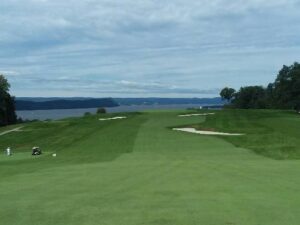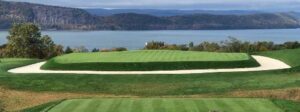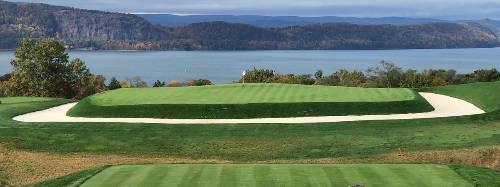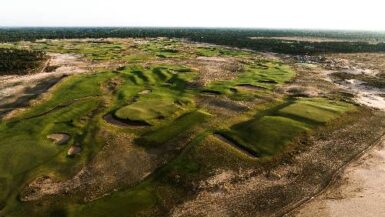
Welcome to Jay’s Insider Guide. Knowledge is power, and forewarned is forearmed. The JIG is your study guide and ideas for a game plan. All you need to do is execute.
This episode – Sleepy Hollow Country Club
—by Jay Flemma, Special to the Golf News Net for the 2023 USGA Mid-Amateur—
SLEEPY HOLLOW, NY –Sleepy Hollow Country Club is as quintessential to American golf design and Washington Irving’s The Legend of Sleepy Hollow is to American literature.
The year was 1913, and Charles Blair Macdonald, expert golfer and notorious rakehell had just conquered the golf design world. Talking the talk and then walking the walk, Macdonald, with the help of engineer and second in command Seth Raynor designed and opened National Golf Links of America – essentially a pastiche of 18 of the greatest golf holes from around the globe.
It was a runaway success. Like the Mona Lisa spawned a cottage industry of Renaissance masters painting the daughters of rich patrons, so too did developers from across the United States line up to have Macdonald, Raynor – and later, after Macdonald’s death, Charles “Steamshovel” Banks – have them design and build indisputable masterpieces all across America.
Sleepy is indeed a grande dame of their incendiary portfolio. Opened in 1914, it was no less a power trio than William Rockefeller, Cornelius Vanderbilt and the estate of John Jacob Astor who hired Macdonald to design a course across a majestic 340-acre Vanderbilt property tucked in the Hudson highlands, hard by the sun-dappled Tappan Zee and beneath the rocky ridges of the mighty Palisades.
I once wrote it was the kind of place you propose marriage to your girl.
Macdonald incorporated many of the strategic hole designs he showcased at National and that are now staples of the Macdonald-Raynor-Banks palette of design strategies. Though land swaps and intervening architects erased several original holes, a long restoration project conducted in two main phases by Gil Hanse, has restored what could be restored and recreated what Macdonald might likely have designed. I predicted the year that Hanse’s work debuted that it would sweep every restoration award category that the major magazines have, and it did. The golf course presents itself perhaps better than it has in all its illustrious history combined. It plays even better than it looks, as every cunning design element has been polished to a high shine by superb conditioning.
The tournament format will consist of two stroke play rounds on Saturday and Sunday September 9-10; one round will be played at Sleepy Hollow Country Club and the other at nearby Fenway Golf Club, an A.W. Tillinghast design equally worthy of praise and examination for its architectural marvels. The 264-player field will be reduced to a 64-player, single-elimination match play bracket.
Macdonald-Raynor-Banks courses, with all their brilliant quirks and quixotic puzzles, make for excellent match play venues, and Sleepy Hollow shines brightly in that regard as fates can swing precipitously on every shot, at any hole, 1-18. You don’t just run away and hide at Sleepy Hollow, especially as the number of half-par holes continues straight through the end of the round.

The course plays to a par 35-36=71. Though short on the card – a mere 6,840 yards for this, the 42nd USGA Mid-Amateur – the constant elevation changes make a mockery of the yardage on the card, as do the fickle winds that can swirl off the river.
Still, there are places where the game plan calls for aggression. It may be true that sometimes “the U.S. Open wins you,” but you have to go out and win the Mid-Am, and it is a gauntlet: two different formats and a grueling six-round bracket. Eight rounds in six days, and no room for error as the talent in the international field is world class. Let’s take a closer look at how to approach Sleepy Hollow Country Club.
Hole 1 – The LEVEN, par-4, 413 yards
Watch out right from your opening tee shot as a once pushover four is now anything but. A large mound distributing fickle bounces sits front greenside right caroming golf balls every which way. Therefore the optimum tee shot is left-center which brings into play a nasty fairway bunker and the end of an awkwardly dog-legging fairway.
Holes 5-7 – ATTACK, ATTACK, ATTACK
After a strong opening stretch, the golfer has a chance to make up ground at this modest-length par-4, par-5, par-3 stretch. The gorgeous fifth takes the player directly to the glorious Hudson with a skyline green and lonely flag silhouetted against the bluebird sky: nigh incomparable beauty. The short par-5 sixth features a two-level fairway to be carried off the tee and Principal’s Nose bunker complex to be avoided. But at a paltry 470 yards, this hole should yield the lowest stroke average on the golf course. Finally, the downhill Reverse Redan (or “Nader” if you have to be pedantic about it…) at the seventh should see its share of birdies from mid-to short iron approaches. Someone in the field could card an ace here; it’s one of two likely candidates…

8-11 – SURVIVE THE NEW HOLES
A prior greenskeeper stated that Gil Hanse took the course’s shortcomings and turned them into strengths. Nowhere is that tuyer than at the eighth: formerly a Tillinghast straightaway, and now a Road Hole a la the iconic 17th at the Old Course at St. Andrews. Uphill, narrow, long (485 at longest), it’s a beast, easily the hardest hole on the outward nine. The ninth is now a short but devilishly guarded Knoll hole, with cavernous bunkers surrounding its tiny green. At 421 yards it’s just a drive and a pitch for the field, but mistakes are punished severely and bogeys hurt extra hard at holes that could give out an easy birdie with two good shots.
The tenth is a gorgeous, but deadly par-3. The green at the turnaround point of the course sits like a lonely mariner atop the crow’s nest of a ship, searching earnestly toward what end the golfer does not know. Gil Hanse expanded this green by 33% in his renovation, but he also added an insidious fold in the green. This would be a great place for fans to sit and have lunch and watch the drama unfold, whether the hole is located at the water’s edge or near the green’s fold. At just 162 yards, the players easily could card anything from hole-in-one to triple bogey.
12, 15, and 16 – BACK TO ATTACK
Sleepy Hollow, like many great courses, is vulnerable at the par-5s, especially so because they are short and the strategies are well-known. The 12th features a double plateau green, but at a mere 531 yards, so long as the tee shot is placed appropriately, the tiny green is accessible for a long club…dangerous, but accessible at the same time. Just don’t compound the mistake of missing the green with the mistake of missing the correct tier for the birdie putt, otherwise you’re begging for a par.
15 is Your author’s second favorite Macdonald-Raynor-Banks template hole – the Alps. (My fave is the Biarritz, for those of you scoring at home.) At just 530, the golfer’s will all have a chance to reach in two. The second shot is blind and over a series of bunkers, but to a punchbowl green. The contours feed the ball to the middle, the greenskeeper pins the perimeter for defense. Fiendishly clever in its intricacy, once again Golden Age architecture shows the way forward.
An Honorable Mention award must go to the new 14th green. The green was expanded from a diamond shape that tested both length and accuracy to a more rectangular shape that slopes away from the player. Hanse brilliantly added two long, parallel spines colloquially called “the Rails” which add fiendish contours and affect nearly every putt, chip, pitch shot, and approach. This is another terrific place to watch fortunes swing late in the round.
THE MAJESTIC 16TH – Par-3, 145 yards
The piece de resistance of the golf course – the Brobdingnagian square green with its thumbprint in the center and roll-offs in dangerous places. Could we see the championship won here with the lapping shores of the Hudson rolling serenely in the distance? The USGA and Golf Channel sure hope so. So will some lucky golfer. No matter what, this is the place for the fans to take that photo for their Facebook profile.






